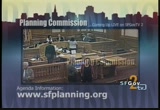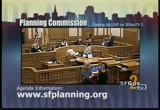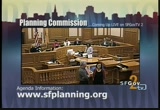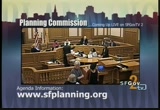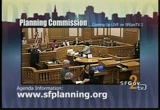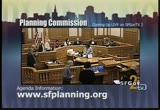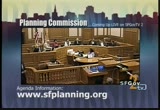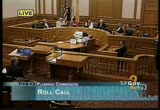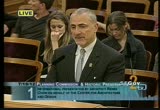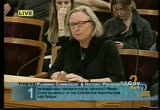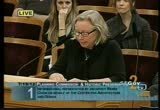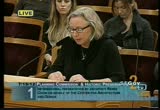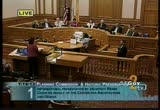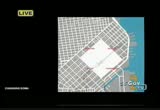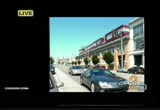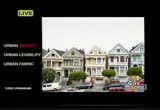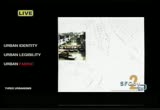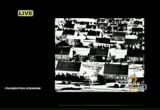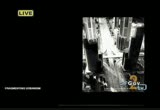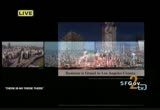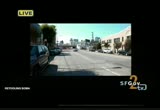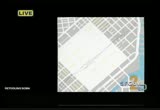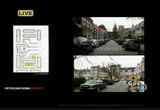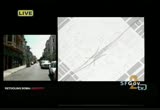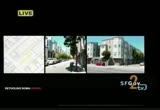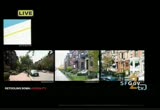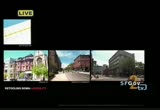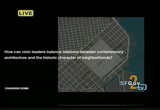tv [untitled] July 19, 2012 5:00pm-5:30pm PDT
5:06 pm
>> good afternoon. this is a joint meeting between the planning commission and the stohr preservation commission for july 19, 2012. i would like to remind everyone to silence or so phones and any other electronic devices that may sound off. moore? here. sugaya? borden? cindy wu? i have a quorum of the planning commission, chase? haas/ ? martinez? we have a quorum of the historic
5:07 pm
preservation commission. this is on the grants. >> thank you, commissioners. i just wanted to make a few comments of introduction before i introduce her, first, thank you for both commissioners for bearing with us. this was my responsibility for getting * mixed up. i appreciate your forbearance -- for bearing with us on that ledge. yes i have the your coming with us -- coming together with us for the special item. this is a project it that we have been working on for a while, and has offered a partnership with us on this design challenge, to come merida with innovative ways to deal with the -- come up with innovative ideas for the design
5:08 pm
problem related to the additions and the new construction in the historic districts, south of the market district and how these may be approached. we will have some interesting possibilities and approaches to this challenge. i will introduce driscoll, who will talk to you about the program. and how the design program is organized. thank you. >> i am the executive director with the center for architecture and design. i am happy that this is something that is fine, because this will be different than a lot of the presentations that you will see. we do a variety of programs for the community as well as professionals. in 2005 we established the center for architecture and
5:09 pm
design, which was focused on working with the general public on issues of design. since 2007 we've partnered with the magazine, which is no longer with us on matching designers with design challenges to rethink the intractable urban problems. with a degree from the national endowment for the arts, we developed five design challenges with the nonprofits and city agencies this year. the other clients include the city department of emergency services, the seven cisco bicycle coalition, the visitors bureau. results of these other challenges will be presented at the architecture and the city festival on september 27. this evening's presentation -- this year we added a focus on developing new forms of community engagement. over the last few days we were closely with twitter over the design of tonight's
5:10 pm
presentation to provide links to this presentation with their internal network, to create an opportunity for you, as a civic leaders to engage in dialogue beyond the boundaries of this room. if you tweet, use #rethink soma. we're wanting to engage workers and visitors beyond the dialogue with those who may not normally come to this meeting. we'll be working with the planning department to figure out what you may want to do with these comments. we approach to planning and preservation department in january with a question, how can civic leaders balance the desire for sustainable architecture in san francisco? at the request of the planning
5:11 pm
director week limited as to the south market neighborhood. we would like to express our thanks to the director as well as david winslow, and tim fry for their accessibility to answer numerous questions. the presenters and night is renée shall, she is an associate professor and the co-chair of the urban design program. she is not have a conflict with anything within the city of san francisco. she is part of the design of never does, with suburban space and the fabric of dwellings, which received a national award, and she has over 25 years of experience in architectural planning and research on projects. with that i would like to introduce you to renee chow.
5:12 pm
>> do you know -- >> sfgtv will turn it on. >> i am delighted to be here. i don't know if my students feel this way. the problem i have aside -- how can civic leaders balance the measure between architecture and the historic character of neighborhoods? i know that she has said thank you but i want to repeat this. i want to thank margie for assigning me this problem, and i want to thank john for saying that we should look into so much, and the areas between second and sixth, and my thanks to tim fry, david winslow, and i
5:13 pm
also want to thank you very much for putting this into what i know is a busy agenda for the evening. thank you very much. my husband was also planning commissioner in our home town. he comes home upset with the architects did in front of the podium and spend all evening lecturing him. if you feel that there is a question along the way that you would like to interrupt, let's make this into a discussion. the aia expected me to talk about how tad on to historic buildings. maybe i would talk more about finding building features, or how we locate buildings and facades. i would like to share how i look at some of. the ways of architecture supports the urban traditions,
5:14 pm
the ongoing special practices, and future development. i am losing my text. i began with cities as an urban setting. each time we build we contribute, and for me, this is about the daily life as experienced by the residence, the workers and visitors. i think about this in three ways. the first is that this is an urban identity. what is the unique character of selma? how was this remembered as distinct from other districts? other cities that we know, like charleston, this is fun to do. going back to my slides of my favorite cities. amsterdam, berlin, how was this
5:15 pm
different than other districts in san francisco? second, i think about this -- how easy is the city to be used, to be navigated? we look at new york city, and the blocks are very narrow and long, and if you stand in the intersection, you can immediately tell if you are moving to the north or south, or east and west in the city. how does -- how do the plan marks and districts, the orientation -- when you move through, you are moving on top of the rich with the topography, and you also look to the towers of the next plaza, so you find your way through the city. these qualities are built with urban fabrics. for me, urban fabrics talk about how individual parts fit
5:16 pm
together. this is not just continuity of public spaces, but the interweaving of public and private, together. seeing these cities as fabrics -- allows them to design this within a project but within the district and within the city. in my research, the landscapes that flourished and endure are rich in urban fabrics. revealing the choices of residents and visitors alike. the settings are admired for the multitude of ways that they support being in place in the city in the neighborhood, and in the room. in viewing of the long, tradition of the city building, these have been the norm. it is not until the middle of
5:17 pm
the 20th-century that development and design move from building fabrics to building objects. after world war two, middle- class americans were encouraged to move into the suburbs. with miles of highways and subsidies for family homes. city centers were depopulated and buildings were abandoned. federal funding supported raising city land, either to build new infrastructures, or for urban renewal. it was at this time that there was a cultural paradigm shift in the rebuilding of the cities. everything was a clear sight, without historical or cultural or formal connection to the larger context, which is the city. as a result, the emphasis for
5:18 pm
building uniqueness moved from the urban fabric to the individual building. distinctiveness was and still is achieved by intentionally separating and disengaging the project from its context. buildings were associated with corporations or architectural source of form, not the place. i can talk about los angeles. when the objects are more important than the relation, the objects are more important than the relations between the project. vehicles seem to dominate the public spacing. urbanism is fragmented. today, we have a culture that rewards the extraordinary, ordinary, rather than making the ordinary, extraordinary. there is no there there, and
5:19 pm
this is part of the effect of fragmenting. they homogenize the difference between those in the city, we could extend gertrude stein and say that this is not anywhere. my first book was about the american suburbs. the book i am finishing now has about chinese urbanism. in china the fragmenting phenomenon most rampant right now. when i am there, this is san francisco that i use as an example of planners and architects working to sustain urbanism. i feel like today there is the easy job of preaching to the choir. the question is, how do we make individual actions in the city at up? preservation is not enough.
5:20 pm
there is no such thing as a building that does not contribute when it comes to the urban identity. how can this change to be more identifiable, more legible, and a distinct urban fabric. some may be perilously close to having no "there" there. this area of soma may just be a district people drive through on the way to the highway. there is the eclectic collection of buildings and there is no area of building types of similar building material, there are not even that many buildings that are historical landmarks. one of the keys to a growing economic life needs to be retooled and revitalized as a vibrant district in the city.
5:21 pm
to do this i would like to talk about the urban potential. i think that there is the urban heritage that is already embedded in the city structure. now this is really -- we all know this. with the plans of san francisco, we have the original planning for the south of market. this is similar to the north of market with the six squares aggregated together. the differences are that the block dimensions are much larger in summer than in the market. -- soma than in the market. a structure of lands has emerged. there we go. these are often closed at the end, giving them the unique urban structure with both through streets and the non- through lanes. these are opportunities to
5:22 pm
identify the intensity -- and this is not a slide. this is leading particularly well. you won't see this off of the marker. they have areas highlighted to show where all lanes are. what i would like to do is use a few other things to show the potential -- first as in boston. they have these narrow parks on the cross lines, and gateways and transition zones into the lane, built from the urban landscaping, with horizontal continuity between the two buildings and the intersection that you can see, one street leading to the building beyond. you feel that you are inside of the block. this is south amsterdam, where the lanes are also in the
5:23 pm
intersections and you can see the use building setbacks of the block and there, there is a gateway at either end for the building. soma as the land structure as well. you can see this in south park in the residential enclave, and there are few amazing gateways, and i am helping on the screen you can see all the yellow dots that i have highlighted there, these are opportunities to build a stronger identity, but you can see -- what the corners look like as you move. particularly up sixth street. another way to change soma is to extend the urban fabric.
5:24 pm
part of it comes from this fine- grained fabric. there are many small lots that give density and character to the street. we have always have the large and small lots and combinations, current development requires increasingly large lots to provide parking, and implement the sustainable strategies, where this is achieved at larger sizes. you can see the loss at 20,000 square feet that seymour reliable -- seem more reliable. larger developments take up larger segments of the block because the block is more narrow. the question that you may consider is how the size contributes or diminishes to the
5:25 pm
fine grain urban fabric? this is an interesting case study, the better known view of the project from folsom streets. but this is what i would like to talk about. let's compare the two design approaches to the center of the block. 150 feet. the one on the left, this goes into the center, and the unit moves in from one end and it goes into the unit from there. the plan on the right is a schematic, it puts parking in the middle, and they enter from the street. both of them are good schemes out of context. when you set these schemes and to sum up, -- soma, it takes
5:26 pm
away from the vitality of the lanes and diminishes the identity. even with the residential units, this has to be enriched with how people moved through the place. the residents move in, leaving a blank wall that you can see with the slide examples. in the middle, is the blank wall to the right. with the parking in the center, the residence look and move outward, adding life to the lanes. the third strategy for retooling, looking at the first streets, the named and the numbered streets. with the large block dimensions that we have, you cannot use the street intervals, like in new york city. this is where the architecture can make a difference.
5:27 pm
i will return back to boston as an example. the longstreet's are highlighted on your screens as the yellow streaks moving parallel to the river, and even though each street has a different section, they all share the pattern of injury, and bay windows. it sounds a little bit like san francisco. the cross streets, they move from the river, and to the river, and the buildings engage the streets differently. along this street they are very few inches along the edge and if there is an entry, this is recessed. so when you are in there, you always know if you are moving parallel or perpendicular to the river. because this is so clear, the newer and the older buildings
5:28 pm
maintain this orientation. i think they have opportunities to increase their legibility. the main streets are associated with moving to and from the water, the number streets are associated with moving up and down the peninsula. how can this be made more legible. one opportunity is to look at the use of corners. these are sights that are vacant or have small buildings in the middle of a lot that is open. and so the corners are not directional. as soma changes, building heights and block corners, are all opportunities to clarify the legibility. there has been a conflict between those who want to keep
5:29 pm
things as they were, and those who want everything to be new. if we accept this polarity, the debate for growth and change, then the debate for growth and the inevitable change in cities is an intractable problem. but if we return to the original question, i would like to strike at two words. i find that tradition and heritage, in the urban structure. i see the architectural history as a continuum, with every building an expression of its culture. history is being made. this is part of a continuum, and so this is part of a change to advantage. i will be not answering a question, but
160 Views
IN COLLECTIONS
SFGTV2: San Francisco Government Television Television Archive
Television Archive  Television Archive News Search Service
Television Archive News Search Service 
Uploaded by TV Archive on

 Live Music Archive
Live Music Archive Librivox Free Audio
Librivox Free Audio Metropolitan Museum
Metropolitan Museum Cleveland Museum of Art
Cleveland Museum of Art Internet Arcade
Internet Arcade Console Living Room
Console Living Room Open Library
Open Library American Libraries
American Libraries TV News
TV News Understanding 9/11
Understanding 9/11